FSU Geography Newsletter 2010 Gaining a Reputation for ...
FSU Geography Newsletter 2010 Gaining a Reputation for ...
FSU Geography Newsletter 2010 Gaining a Reputation for ...
Create successful ePaper yourself
Turn your PDF publications into a flip-book with our unique Google optimized e-Paper software.
<strong>FSU</strong> <strong>Geography</strong> <strong>Newsletter</strong> <strong>2010</strong><br />
Chair’s Column<br />
<strong>Gaining</strong> a <strong>Reputation</strong> <strong>for</strong> GIScience<br />
The <strong>Geography</strong> Department continues to<br />
promote excellence in spatial research,<br />
particularly the development and application of<br />
geographic in<strong>for</strong>mation science (GISci) <strong>for</strong><br />
dealing with many questions on human‐<br />
environmental interactions. Indeed the<br />
department is rapidly building an enviable<br />
reputation <strong>for</strong> GIS research and teaching. The<br />
master’s degree in GIScience has established<br />
national credibility in the way it balances<br />
theoretical developments in spatial<br />
representation with technical operations in<br />
spatial analysis. Demand <strong>for</strong> GIS from students<br />
and employees was now high enough to<br />
warrant the creation of an online graduate<br />
certificate in fall <strong>2010</strong>. Thanks are due to<br />
Academic & Professional Program Services <strong>for</strong><br />
their financial support in allowing geography<br />
faculty to be released from regular teaching and<br />
develop online courses <strong>for</strong> the certificate.<br />
GISci educates and trains students to not only<br />
map or position the world using GPS but to also<br />
synthesize problems and advocate alternate<br />
solutions. The GISci alumni already stand at 91,<br />
starting with 12 students in 2005‐2006 and<br />
ballooning to 35 students currently enrolled in<br />
the <strong>2010</strong>‐2011 year. Many have secured<br />
rewarding careers in the Florida public sector<br />
with institutions such as the Department of<br />
Environmental Protection, the Department of<br />
Health, NW Water Management, Natural Areas<br />
Inventory, the Department of Transport, and<br />
Leon County GIS. Others have ventured beyond<br />
Florida or into the private sectors; the Michael<br />
Baker Corporation in Baton Rouge and Louisiana<br />
Tech University, and Spatial Networks in Tampa,<br />
UF Fort Lauderdale Research and Education<br />
Center and Citizens Property Insurance in<br />
Tallahassee respectively.<br />
The job titles vary to some degree but<br />
commonly orbit around “GIS manager,”<br />
“geospatial analyst,” and “GIS technician.”<br />
Collin Fridley (Masters GIS 2007) has been<br />
working as a GIS Specialist <strong>for</strong> the US Army. He<br />
says, “working <strong>for</strong> the Army has proved to be a<br />
fruitful career that's full of great opportunities.<br />
I'd recommend the master's in GIS program at<br />
<strong>FSU</strong> to anyone interested in pursuing or building<br />
upon a career in GIS”. Scott Weisman (Masters<br />
GIS 2008) has been so successful at Leon County<br />
GIS that he now teaches a class on the same<br />
program he graduated from, his course is “GIS<br />
and Government.” And finally, Brenda Green<br />
(2006) works <strong>for</strong> the GIS & Communications<br />
Services, at the John Scott Dailey Florida<br />
Institute of Government. She says, “my time as<br />
a GIS Graduate Student was time very well<br />
spent, and I greatly appreciate the ef<strong>for</strong>ts of<br />
each of my professors as they shared
in<strong>for</strong>mation and insights into cutting edge<br />
technologies, while instilling the ideals of best<br />
practices and the benefits of good science to<br />
humanity. I was <strong>for</strong>tunate to win a competitive,<br />
12 month internship with the Florida Institute of<br />
Government at Florida State University while<br />
still in the MS‐GIS program and remain happy<br />
with this group as a career professional, four<br />
years later. One of our most recent<br />
accomplishments is currently highlighted on the<br />
<strong>FSU</strong> website. I am very pleased to have played a<br />
role in this endeavor.”<br />
http://www.fsu.com/Featured‐Stories/<strong>FSU</strong>‐<br />
helps‐North‐Florida‐region‐secure‐30‐million‐in‐<br />
federal‐funding‐to‐increase‐high‐speed‐<br />
Internet‐connectivity‐in‐rural‐areas<br />
In other news, three doctoral students<br />
successfully defended their dissertations: Kelly<br />
Watson who took up employment in the<br />
Department as a full‐time teaching instructor in<br />
geography; Kelsey Scheitlin who is now an<br />
assistant professor of geography at Longwood<br />
University in Virginia; and Sunny Sim who is an<br />
assistant professor of geography at the<br />
University of North Alabama. In addition, eight<br />
master’s degrees in geography were awarded.<br />
Faculty News<br />
Victor Mesev<br />
Victor Mesev, Professor<br />
& Chair, Bellamy 323A,<br />
850/645‐2498,<br />
vmesev@fsu.edu.<br />
Victor’s research is on<br />
the integration of GIS<br />
and remote sensing. He teaches courses on<br />
maps and advanced geographic in<strong>for</strong>mation<br />
science. He recently presented his on urban<br />
remote sensing at conferences in Chile and<br />
China, as well as completing work on the use of<br />
GIS in unraveling the distribution of sectarian‐<br />
fueled deaths in Northern Ireland (Annals of the<br />
Association of American Geographers).<br />
2<br />
Jim Elsner, Shaw Professor,<br />
Bellamy 310, 850/644‐8374,<br />
jelsner@fsu.edu.<br />
Jim’s research explores the<br />
tracking of hurricane activity.<br />
He teaches quantitative<br />
methods courses and storm<br />
chasing. An international expert on hurricane<br />
tracking and damage Jim frequently publishes in<br />
Geophysical Research Letters and <strong>for</strong> the<br />
American Meteorological Society. He holds<br />
annual meetings on hurricanes and climate<br />
change.<br />
Phil Steinberg, Professor,<br />
Bellamy 305, 850/644‐8378,<br />
psteinbe@fsu.edu<br />
Phil is the director of <strong>FSU</strong>’s<br />
Social Science & Public Affairs<br />
Living‐Learning Community<br />
and chair of the <strong>FSU</strong> chapter of the United<br />
Faculty of Florida. Phil was recently awarded a<br />
major grant ($377,000) from the National<br />
Science Foundation to conduct research on<br />
Arctic sovereignty claims and had articles<br />
published in the Annals of the Association of<br />
American Geographers and Political <strong>Geography</strong>,<br />
as well as presenting at international confer‐<br />
ences in Canada, Finland, and the United States.<br />
Phil’s international reputation was further<br />
recognized when he was asked to join the<br />
editorial board of The Journal of the Indian<br />
Ocean Region and named reviews editor of<br />
Political <strong>Geography</strong>. His work on Arctic<br />
sovereignty was widely publicized by a number<br />
of media outlets including USA Today and The<br />
Toronto Globe & Mail.<br />
Jay Baker, Associate Pro‐<br />
fessor, Bellamy 303,<br />
850/644‐8380,<br />
jbaker@coss.fsu.edu.<br />
Jay investigates human<br />
responses to natural<br />
hazards and emergency<br />
preparedness, especially as a result of hurricane
activity. He teaches courses in natural hazards<br />
and physical geography. Recently Jay<br />
contributed a chapter to a book dealing with<br />
the use of survey methods in transportation<br />
research and had an article about household<br />
preparedness <strong>for</strong> hurricanes accepted <strong>for</strong><br />
publication in Applied <strong>Geography</strong>. He also<br />
conducted a study <strong>for</strong> the Florida Department<br />
of Community Affairs dealing with evacuation of<br />
tourists in the Florida Keys and is starting two<br />
studies concerning hurricane evacuation with<br />
support from the Florida Catastrophic Storm<br />
Risk Management Center. He was a keynote<br />
speaker at the National Evacuation Conference<br />
in February, and his work in organizing the<br />
National Hurricane Conference continues.<br />
Tony Stallins, Associate<br />
Professor, Bellamy 317A,<br />
850/644‐8385,<br />
jstalllin@mailer.fsu.edu.<br />
Tony continues his research<br />
into urban lightning and<br />
teaches biogeography and<br />
research methods. This year<br />
Tony made breakthroughs<br />
in the climatological radar delineation of urban<br />
convection (published in the International<br />
Journal of Climatology) and urban cloud‐to‐<br />
ground lightning (in Earth Interactions).<br />
Xiaojun Yang,<br />
Associate Professor,<br />
Bellamy 321, 850/644‐8373,<br />
xyang@fsu.edu.<br />
Xiaojun works on estuarine<br />
remote sensing and teaches<br />
classes on geovisualization<br />
and environmental GIS, remote sensing and<br />
geovisualization. Recently he published Remote<br />
Sensing and Geospatial Technologies <strong>for</strong> Coastal<br />
Ecosystem Assessment and Management, and<br />
co‐authored an edited volume, Remote Sensing<br />
of the Earth Surface Process. Xiaojun also co‐<br />
chaired the scientific committee <strong>for</strong> the Second<br />
International Conference on Earth Observation<br />
<strong>for</strong> Global Changes in Chengdu, China, and was<br />
3<br />
honored as a senior investigator <strong>for</strong> an<br />
international research partnership project<br />
‘Ecosystem Processes and Services’ (funded by<br />
the Chinese Academy of Sciences and China’s<br />
State Administration of Foreign Experts) <strong>for</strong> the<br />
next five years.<br />
Mark Horner Associate<br />
Professor, Graduate<br />
Director, Bellamy 306,<br />
850/644‐8377,<br />
mhorner@fsu.edu.<br />
Mark continues to<br />
manage our graduate<br />
students and continues to<br />
work on research looking at GIS and hurricane<br />
disaster relief. He teaches GIS, spatial data<br />
analysis, and urban modeling. Mark continues<br />
his research on the spatial modeling of<br />
hurricane disaster relief (Environment and<br />
Planning B) and the role of Voronoi diagrams in<br />
GIS (International Cartographic Association’s<br />
specialist meeting in Sweden).<br />
Lisa Jordan, Assistant<br />
Professor, Bellamy 311,<br />
850/644‐8386,<br />
ljordan@fsu.edu.<br />
Lisa is focused on issues<br />
of fertility, religion and<br />
population. She teaches<br />
classes in GIS and medical geography, and<br />
recently helped develop a web‐based GIS tool<br />
<strong>for</strong> USAID called ‘Population Explorer.’ It was<br />
used in planning response to disaster in the<br />
aftermath of the earthquake in Haiti, with plans<br />
to <strong>for</strong>mally incorporate the tool into the USAID<br />
Famine Early Warning Systems website. Details<br />
are currently featured in Field Exchange, a<br />
magazine published by the Emergency Nutrition<br />
Network.<br />
Tingting Zhao, Assistant<br />
Professor, Bellamy 304,<br />
850/644‐8379,<br />
tzhao@fsu.edu.<br />
Our most recent faculty
addition, Tingting conducts research on<br />
accounting carbon impacts from residential<br />
development across the U.S. She teaches<br />
environmental science, GIS customization, and<br />
landscape ecology. Recently Tingting and Mark<br />
Horner have both been involved with <strong>FSU</strong>’s<br />
IESES (Institute <strong>for</strong> Energy Systems Economics<br />
and Sustainability) initiative focusing on several<br />
projects dealing with interactions between<br />
transportation and energy consumption. They<br />
jointly submitted two manuscripts to a special<br />
issue on energy to be published by the<br />
geography flagship journal addressing energy<br />
sustainability and carbon mitigation.<br />
Kelly Watson, Instructor,<br />
Bellamy 309, 850/644‐<br />
8375, kcw03c@fsu.edu.<br />
Kelly is now a full‐time<br />
instructor and our<br />
undergraduate advisor <strong>for</strong><br />
the environmental studies<br />
and geography majors.<br />
She has also taken the role of program director<br />
<strong>for</strong> the online graduate certificate in GIS. And<br />
yet Kelly continues her research on environ‐<br />
mental issues conservation and cultural impact.<br />
Patrick O'Sullivan, Emeritus Professor, Bellamy<br />
302, 850/644‐8381. Pat teaches classes on<br />
Europe and Britain & Ireland.<br />
Mort Winsberg, Emeritus Professor. Mort teaches<br />
classes in Latin America and Florida.<br />
John Fradel, Adjunct. John continues to teach our<br />
very large classes in world geography, Europe,<br />
and the Middle East.<br />
Graduate Student News<br />
Kelsey Scheitlin (PhD <strong>2010</strong>) successfully<br />
defended her dissertation, “Construction and<br />
application of a spatial hurricane climatology.”<br />
Sunny Sim (PhD <strong>2010</strong>) successfully defended<br />
4<br />
her dissertation, “A geospatial approach to<br />
measuring and modeling the impact of urban<br />
growth on ecosystems: Orlando case study.”<br />
Kelly Watson (PhD <strong>2010</strong>) successfully defended<br />
her dissertation, “Tupelo Forests and Honey<br />
Production along the Apalachicola River of<br />
Northwest Florida: Livelihood Preservation and<br />
Forest Conservation in a Changing Rural<br />
Landscape.”<br />
Congratulations to Michael Nesius <strong>for</strong> been<br />
awarded a National Science Foundation<br />
Doctoral Dissertation Research Improvement<br />
Grant <strong>for</strong> "The Evolution of Food Networks:<br />
Foodscale Connectivity, Egocentric Networks,<br />
and Social Contagion in Community‐Supported<br />
Agriculture."<br />
Congratulations to Jill Malmstadt, whose paper,<br />
“risk of strong winds to Florida cities” was<br />
accepted in the American Meteorological<br />
Society's Journal of Applied Meteorology and<br />
Climatology. She also presented this work at the<br />
29th Conference on Hurricanes and Tropical<br />
Meteorology in Tucson, AZ.<br />
Congratulations to Adam Keul <strong>for</strong> being<br />
awarded a National Science Foundation<br />
Doctoral Dissertation Research Improvement<br />
Grant, <strong>for</strong> his dissertation on "social spatializa‐<br />
tion in the Atchafalaya Basin."<br />
Staff
Congratulations to Brenda Daniels on her<br />
marriage to Roosevelt Lamb. And to Christina<br />
Dippre, and Shawn Lewers <strong>for</strong> keeping the<br />
Department ticking.<br />
Departmental Publications<br />
Jay Baker <strong>2010</strong> Household preparedness <strong>for</strong> the<br />
aftermath of hurricanes in Florida Applied<br />
<strong>Geography</strong><br />
Jay Baker 2009 Capturing travel behavior during<br />
exceptional events In Transport Survey<br />
Methods: Keeping up with a Changing World<br />
London: Emerald<br />
Jim Elsner, T Jagger and R Hodges <strong>2010</strong> Daily<br />
tropical cyclone intensity response to solar<br />
ultraviolet radiation Geophysical Research<br />
Letters 37<br />
T Jagger and Jim Elsner <strong>2010</strong> A consensus<br />
model <strong>for</strong> seasonal hurricane prediction<br />
American Meteorological Society<br />
K Scheitlin, Jim Elsner, J Malmstadt, R Hodges<br />
and T Jagger <strong>2010</strong> Towards increased utilization<br />
of historical hurricane chronologies Journal of<br />
Geophysical Research 115<br />
J Malmstadt, Jim Elsner and T Jagger <strong>2010</strong> Risk<br />
of strong hurricane winds to Florida cities<br />
American Meteorological Society<br />
5<br />
Mark Horner <strong>2010</strong> Exploring the sensitivity of<br />
jobs‐housing statistics to imperfect travel time<br />
in<strong>for</strong>mation Environment and Planning B 37<br />
367‐375<br />
Mark Horner <strong>2010</strong> How Does Ignoring Worker<br />
Class Affect Measuring Jobs‐Housing Balance?<br />
Exploratory Spatial Data Analysis Transportation<br />
Research Record<br />
P Maliszewski and Mark Horner <strong>2010</strong> A spatial<br />
modeling framework <strong>for</strong> siting critical supply<br />
infrastructures Professional Geographer<br />
F Asumda, Lisa Jordan 2008 Minority youth<br />
access to tobacco: A neighborhood analysis of<br />
underage tobacco sales, Health and Place 15<br />
140‐147<br />
Lisa Jordan, B Watkins, P Biegon, M Mwangi<br />
and R Rose <strong>2010</strong> Practical approaches to spatial<br />
estimation of disaster‐affected populations<br />
International Journal of Applied Geospatial<br />
Research 1<br />
Victor Mesev <strong>2010</strong> Classification of urban areas:<br />
inferring land use from the interpretation of<br />
land cover In T Rashed and C Jurgens (Eds)<br />
Remote Sensing of Urban and Suburban Areas<br />
Berlin: Kluwer<br />
S Myint and Victor Mesev <strong>2010</strong> A comparative<br />
analysis of spatial indices and wavelet‐based<br />
classification Remote Sensing Letters 1<br />
Tony Stallins, M Nesius, M Smith and Kelly<br />
Watson <strong>2010</strong> Biogeomorphic characterization<br />
of floodplain <strong>for</strong>est change in response to<br />
reduced flows along the Apalachicola River,<br />
Florida. River Research and Applications 26<br />
M Bentley, W Ashley and Tony Stallins 2009<br />
Climatological radar delineation of urban<br />
convection <strong>for</strong> Atlanta, Georgia International<br />
Journal of Climatology<br />
G Hannes, Phil Steinberg, J Tash, S Fabiano and
R Shields <strong>2010</strong> Contested sovereignty in a<br />
changing Arctic Annals of the Association of<br />
American Geographers 100<br />
Phil Steinberg 2009 Key West’s conch republic:<br />
building sovereignties of connection Political<br />
<strong>Geography</strong><br />
Xiaojun Yang 2009 Artificial neural networks <strong>for</strong><br />
urban modeling In M Madden Manuel of<br />
Geographic In<strong>for</strong>mation Systems ASPRS<br />
Xiaojun Yang 2009 Spatial interpolation In H<br />
Karimi Handbook of Research on Geoin<strong>for</strong>matics<br />
IGI Global<br />
Tingting Zhao, K Bergen, D Brown, H Shugart, V<br />
Kraruk 2009 Scale dependence in quantification<br />
of land‐cover and biomass change over Siberian<br />
boreal <strong>for</strong>est landscapes, Landscape Ecology<br />
S Qi, D Brown, Q Tian, L Jiang, Tingting Zhao and<br />
K Bergen 2009 Inundation extent and flood<br />
frequency mapping using Landsat imagery and<br />
digital elevation models (DEMs) GIScience and<br />
Remote Sensing 46<br />
6<br />
We are always striving <strong>for</strong> excellence in<br />
teaching and research and would appreciate<br />
any tax‐deductible donations our alumni and<br />
friends can give us to raise our international<br />
reputation even higher. Last year many of you<br />
kindly sent us generous donations which have<br />
been used to purchase equipment and software<br />
and to subsidize graduate student travel to<br />
conferences. Please make out checks to the<br />
“Harold McConnell Fund” and send to please<br />
send to:<br />
Chair, Dept. of <strong>Geography</strong><br />
323 Bellamy Building<br />
113 Collegiate Loop<br />
Florida State University<br />
Tallahassee, FL 32306‐2190, USA<br />
Visit us at:<br />
http://www.coss.fsu.edu/geography/index.html<br />
THANK YOU!<br />
Support <strong>FSU</strong> <strong>Geography</strong>




